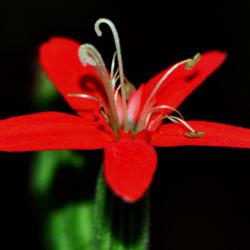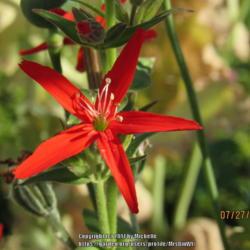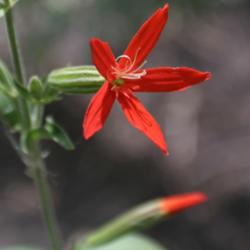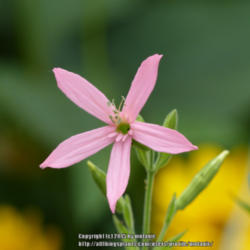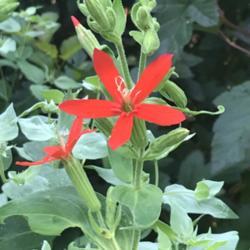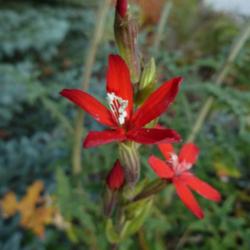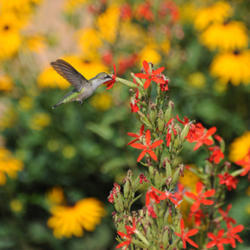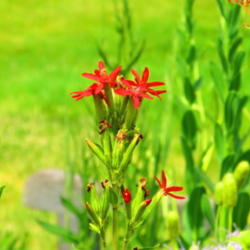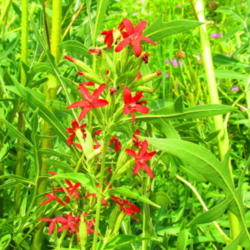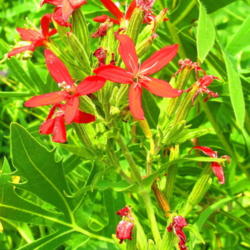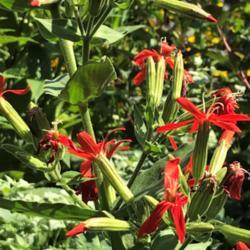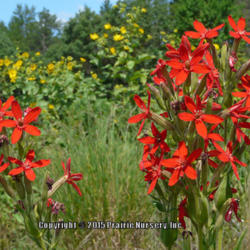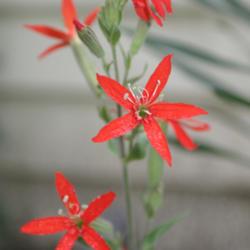Posted by
ILPARW (southeast Pennsylvania - Zone 6b) on Aug 25, 2021 2:24 PM concerning plant:
I've hardly ever seen this rare plant. It is a member of the Carnation Family that grows in mesic to dry soils in prairies and woodland openings in scattered locations in its native range from Ohio through northern Illinois to eastern Missouri down to Louisiana to northern Florida. It gets its name of "Catchfly" in that its very sticky calyx, a greenish sac-like growth below the flowers, catches small insects so that they can not feed from its nectar. Digestive enzymes on the calyx break down the dead insect bodies so that they don't remain on the plant too long. The red flowers attract Hummingbirds and Butterflies, especially the Black Swallowtail, that are welcome to feed on the nectar. The flowers have no scent. The leaves and stems are covered with tiny white hairs to also discourage many insects and give the foliage a gray-green color. The about 2 inch wide flowers have 5 red petals that are not notched like the similar species of the Fire Pink, that is also a smaller plant that blooms earlier. Royal Catchfly is a short-lived perennial that usually self-sows with its tiny black seed, and it has a root system both fibrous and with a taproot. In gardens it likes sandy or gravelly soils best, and needs staking or growing other prairie plants about the same height around to help hold it up. It is sold from various native plant nurseries of the Midwest and South, as Prairie Moon Nursery or Prairie Nursery and from some mail order nurseries of uncommon plants.
Posted by
growitall (Calgary, Alberta, Canada) on Nov 24, 2012 12:48 PM concerning plant:
Hardy in zone 3 and useful for late, colourful bloom.
Posted by
jmorth (central Illinois) on Jul 7, 2012 2:58 PM concerning plant:
5 narrow petals form a star-shape scarlet flower that abruptly flares outward from the long tubular calyx. Leaves have a fuzzy texture and smooth edges. Leaves on stem as opposite pairs rotate 90 degrees as they ascend the stem.
Root system - central taproot and short rhizomes; enables plant to spread vegetatively to form small colonies.
Attracts larger butterflies (black swallowtail) and hummingbirds (ruby-throated green).
Habitat - include mesic black soil prairies, openings in upland forests, savannas, scrubby barrens, and open areas along roadsides and railroads
In Illinois it is uncommon, even rare. Endangered status. In the wild can be found in some northern counties, counties around E St Louis, and a few counties in the central part of state.
I had some plants from the local wildflower society but they never got established. They are often re-introduced to wild prairie habitats.
Posted by
SongofJoy (Clarksville, TN - Zone 6b) on Jan 15, 2012 8:42 AM concerning plant:
Royal Catchfly occurs on rocky and poor soil in thin woods, prairies, and thickets throughout its range in the central US and into Florida. It is rare or endangered in half of the states where it occurs. It is easy to spot when in flower for much of the summer. Growing to 4 feet or so, stout flower stalks bear dozens of brilliant crimson, star-shaped flowers about 1" wide that hummingbirds love. Plants look like very tall leafy Firepinks. Grow Royal Catchfly in average, well-drained soil.


